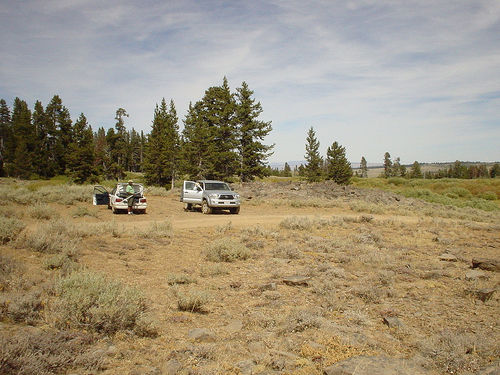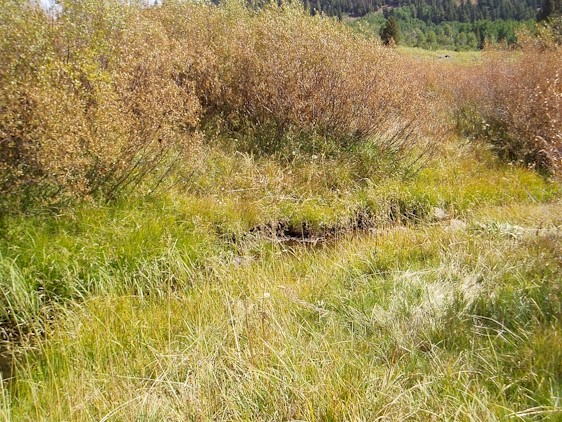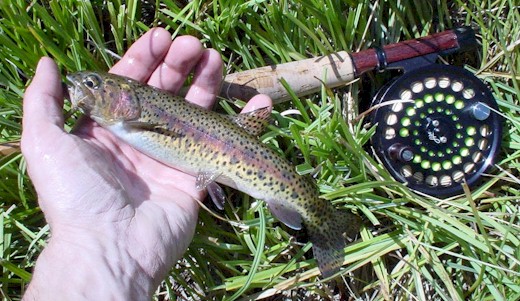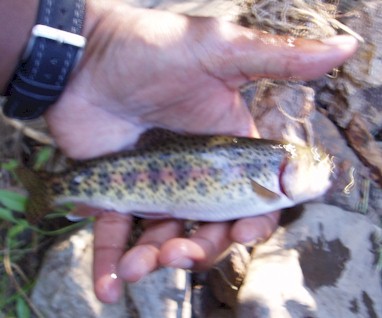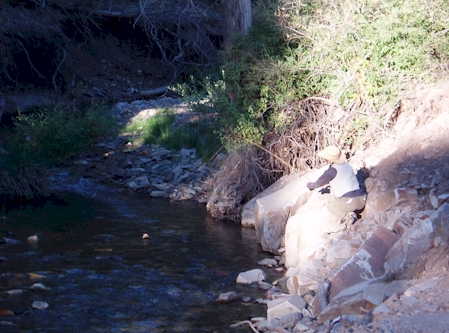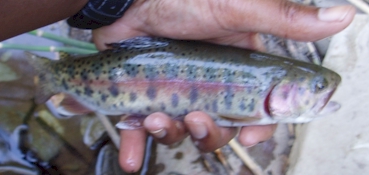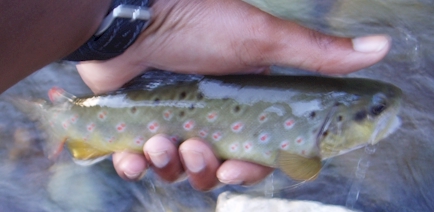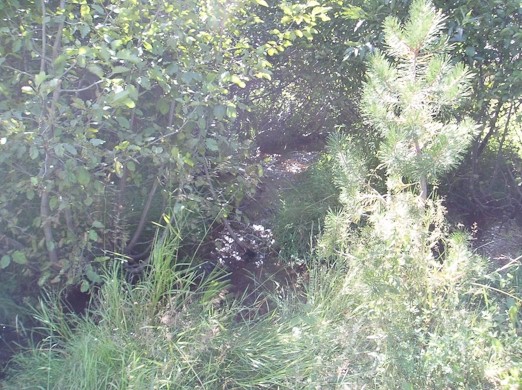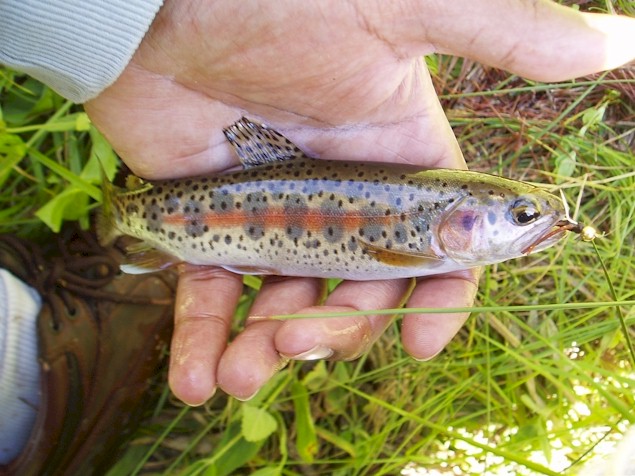|
|
|
|
|
September 3 and 4 Warner and Shasta - Trinity National Forest Time: 2:00pm - 6:00pm Saturday, 2:00pm Ė 4:00pm, 5:30pm -
6:30pm Sunday Fly Choice: Size 16 EHC, Green, Grey and Yellow. Size 12 Prince Aggravator. Size 16 Dom's Red Secret. Narrative: Redband weekend. This weekend Gino, Claire and I headed to the top of the state in search of 3 different strains of Redband Rainbow Trout- The Goose Lake Redband, The Warner Redband and the McCloud River Redband. These 3 species of trout qualify for the Heritage Trout Challenge and are the 3 of the 4 California Trout known by the moniker ďRedbandĒ. The 4th is the Sheepheaven Springs Redband which lives in the same watershed as the McCloud River strain but is isolated to a single spring feed stream, closed to fishing. My quest for Redbands began almost 2 years ago. I'd seen pictures of the McCloud River and Sheepheavan Redbands several years earlier and noticed how remarkably beautiful they were. At the time, I'd heard that they were only available in remote headwater streams, the locations of which would be hard to come by. "I have to catch one of those some day", I thought and then put the idea in the back of my mind. To my understanding, there are two types of Rainbow Trout in California, the Coastal Rainbow (which include Steelhead) and the Redband. All interior sub- species of Rainbow Trout are "Redbands". This includes, the California Golden Trout, the Little Kern Golden Trout and the Kern River Rainbow, as well as the Eagle Lake Rainbow Trout, Warner Redband Trout, Goose Lake Redband Trout, McCloud River Redband Trout and lastly, the Sheepheaven Springs Redband Trout. When the Department of Fish and Game introduced the Heritage Trout Challenge, I thought it would be fun to catch each of the different subspecies of Oncorhynchus Mykiss- the Rainbow Trout. I came up with a list of 7 possible candidates , only 6 of which would be needed to complete the challenge. I chose: The Coastal Rainbow
Trout The first fish, the Coastal Rainbow, would be easy to get. Any trout from the Stanislaus should qualify, especially any sea run trout but if there were any doubt, a simple trip to the Clavey would take care of it. The next 3 strains would also be fairly easy. The Kern Plateau and itís trout are well known and fairly well documented. It would take a little work but I was confident that I could find which streams to target. The Redband Trout was different. The Redband is almost mythical in itís lore. Readily available in Oregon, the Redband Trout in California are restricted to secret, hard to get to headwater streams. Many of them not open to fishing. The McCloud Redband, so the lore goes is almost extinct, hybridized or forced out of itís range by planted fish. Such was the lore, such was my belief- to a point. I figured the Redbands were still available and that their streams may be secret and hard to get to but not nearly as hard as the lore would make it seem. I was right. The internet and the internet search engine are amazing technological developments. We put content out on the internet, thinking that someone, some day might find the information useful. So it was with my search for the Redband. The right combination of words and voila! I found more useless webs sites to search through than you could shake a stick at. Fortunately, they werenít all useless and I happened to find two research studies of Redband Trout in their native range. One study was for the Warner and Goose Lake Redbands and the other was for the McCloud strain. Both included population samples from individual streams by name, complete with stream name and population size. Armed with this information, I identified the only two streams in California inhabited by the Warner Redband, about 4 streams in which to find the McCloud Redband and close to a half dozen streams from which to photograph a Goose Lake Redband. The Goose Lake Redband has a vast range and can be found in streams from the top of the state to headwater streams of the Pit River outside Altruas. My first attempt was pitiful. A friend and I traveled to the upper McCloud last spring and found high water and no trout. On that trip I relied on my National Forest map to provide an accurate lay of the land and of the fire trail. That proved to be a big mistake. My second attempt was half hearted. Going home from the Upper Sac the long way, via highway 299, I decided to make another quick stop at the Upper McCloud late last fall. The water level looked good but the water and air were bitterly cold. Without gloves, I was back into the car within a half an hour. I pledged to myself that this year would be different and it was. Gino, Claire and I met on the road in Burney. After a quick breakfast at the Hungry Moose, we jumped into our respective vehicles and headed north. The drive to Alturas and beyond was pleasant and went by quickly. I had never been any further north on route 299 than Fall River Mills. They call the area the ďInter-Mountain RegionĒ and it is well named. We traveled through one valley after another from Burney to Alturas. We didnít make great time but that didnít matter, at least it didnít matter to me. The only plan I had was to catch 3 fish in 3 days, other than that, ďbahala naĒ! Come what may! Gino says I drive my Corolla like a Jeep and I guess thatís true. Iím pretty much game to drive anywhere until itís proven to me that I canít. That said, Iím glad that both he and Claire were with me and that they have a high clearance vehicle. Although, truth be told, if it rained, weíd both be in a world of hurt because the fire road to the first creek was very steep and when wet would be too slippery to travel in anything other than a 4x4 with aggressive tires. Maybe it's my age, or my experience in May of not having my mothers car start while in the Jemez Mountains, but the for the first time I was feeling a bit vulnerable in my little white car. My Toyota tackled the steepest of grades like a trooper and we arrived at the first stream about 2:00pm.
The first stream was one of Warner Redband streams. I figured the Warner would be the hardest fish to catch because it only exists in two streams. If one stream wasnít fishing, then in theory we could fish the other. If the second stream wasn't fishing, then I was out of luck. I made the declaration that if we hadnít caught fish by 3:00 or 3:30 pm, weíd move onto the next stream. I say in theory because I knew that my car wouldnít be able to get past the dip in the road just beyond this first stream; the angle was too steep. This meant that Iíd have to catch my Warner Redband here. The stream was what I call a gutter stream. A narrow meadow stream with high banks. It was quite dry now but would be pretty dismal in the spring when itís banks would overflow and the surrounding meadow would become a swamp.
Each of us hooked into fish almost immediately and Gino and Claire where ready to move on just as quickly. Unfortunately, I wasnít. You see I hiked downstream and found only small fish, while they hiked upstream and found the mother load of larger fish- significantly larger, 6 inches larger than I had managed to pull out of the stream in the first 45 minutes. Dialed in on what sort of holding water the big fish were in, Gino even hiked down below me and much to my chagrin landed what was probably the largest Redband of the weekend (although, looking at my Pine Creek Redband, Iím not so sure). I, on the other hand, had only seen one fish over 3.5 inches. I scared it out from under a bush, so thatís where I concentrated my fishing, in the tighter, hard to get to holding areas. First Iíd fish an area properly, staying as low as possible, only presenting my leader to where I thought the fish might be. Then Iíd fish the area again standing up and lastly Iíd walk down the bank, hoping to spook fish. Nothing larger than my finger darted away in fear. Except for one vicious take just below the road, I hadnít come close to catching a larger fish.
The upper part of the stream, above the road, was slightly different in character. It was still a narrow gutter stream but there was less stream side brush and more grass. More importantly, this upper section held several deeper holes and with them, larger fish. Claire clued me in to the two larger holes sheíd been fishing. She was beaming. Sheíd hooked what would have been the largest Redband, on her first or second cast. Unfortunately, the dreaded Long Distance Release was in her future and she didnít land the fish. Sheíd been getting several strikes and pointed me in the right direction. When I arrived at the first hole, I was amazed at how large it was. Easily 3 times as wide and long as anything I had fished thus far. Gino was at itís head, presenting his fly down stream. I made my way up stream to the next hole. Today was one of my poor casting days. Iíd been in my front yard casting all sorts of different rods well all week but today when it mattered, I was getting tangled, hanging up and generally missing my target. I must have lost 12 flies on this single stream. This was probably due to the fact that I was a bit on edge. I didnít feel particularly on edge; but, I really wanted to catch a larger fish to photograph and that sort of thing usually puts me off my game a bit. Two weeks ago on the Upper Truckee I floundered until I photographed that first decent fish, afterwards I relaxed, my casting slowed and I started catch more and larger fish. That didnít happen on this sometimes dismal little creek and I never did catch my bigger fish. I hooked into plenty of larger fish in this section, about 6 in the next hour, but botched the landing each time.
The second stream we planned to fish was Pine Creek. It was the main tributary to Goose Lake in this region and as we made our way over the mountain in the early afternoon, I noted all the little streams that we passed. One in particular looked promising and so we stopped at that stream on our down the mountain. The character of this stream was different. The gradient here was sharp and the stream tumbled through a grove of log pole pines. It was here that the first of two trees would fall within a couple of hundred feet of me this weekend. Claire and I were putting our rods together, Gino was fiddling with the dogs, when we started to hear a crackling noise. The 3 of us looked up stream to see a large dead pine fall with a loud thud across the wee stream. It was quite a sight, quite sudden and quite sobering. If we had been fishing the stream or a larger stream, whoís to say that we would have heard the tree over the rushing water and been able to get out of itís way in time. Gnarly roads and falling trees, it really made me appreciate how dangerous it can be when I go out alone. Iím usually on the look out for bears and rattlesnakes but itís the sudden unseen events that get you- the sudden snow storm, stepping in the unseen muskrat hole, the sudden car breakdown. Where the stream passed under the road there was a small plunge pool. It was the most obvious place to fish but I was betting on the fact that most folks donít notice the stream as they make their way to other waters. I slide down the bank, making quite a ruckus as I hit stream side. I worked the pool left to right and quickly turned a fish. It was a good sized fish which came out of the frothy water in the middle of the pool. I made a few more casts, drifting the fly down the same current seam. I put on a Parachute Adams and made two drifts. Nothing. I could have kept fishing dries but we planned to stay on this stream for only half an hour and I didnít have time to screw around. My preferred small
stream nymph is the Prince Nymph or the Prince Nymph variant, the Dark Lord.
I had been two lazy to tie either before this trip and was now regretting
that decision. Iíd been putting off tying these flies for several weeks and
so, picked up Burkís Prince Aggravator fly when I was in Mammoth a couple of
weeks before. The Prince Aggravator looks like a prince nymph except it has
a marabou tail and several rubber legs. I tied the fly on and stuck it in my
mouth; wetting the fly before I cast would make it sink quicker.
The fish hit the fly hard and was quickly to hand. I had my first Goose Lake Redband and it was of respectable photographing size. We still had about 20 mins remaining on this stream so I climbed up the bank and made my way down stream. Down stream the holding water wasnít quite as good but I managed to land two more photo respectable fish. We hopped in the car again, planning on fishing Pine Creek. We came to several turn outs which were curiously posted with fishing regulations and no trespassing signs. I had been warned by fish and game to respect the property rights so we did and where heading out of the wilderness for some food when the creek passed back into public domain. We stopped at a narrow turn out. Claire jumped on a nice looking roadside run and started getting strikes almost immediately. Gino went up stream caught two fish in what must have been 5 minutes. I made my way downstream.
I had to walk quite a
bit downstream before the dense brush opened up and allowed me to reach the
stream. It was tricky but I managed to hop down the bank to a small sand
bar. At the head of the sandbar was the perfect pool- the roots of a fallen
log on the right, a small plunge shelf at the head and local shrubbery on
the left. The area were I was kneeling had obviously been scoured out by
high water. The pool was deep, probably about 2 feet deep. Not knowing what
the hierarchy was in this pool, I made a couple of short casts, hoping to
pull out any small sentinel fish. My third or forth cast was met with a
splash and I pulled out a 7 or 8 inch fish- my 4th Goose Lake
Redband. I thought about moving on. This certainly wasnít a sentinel fish and fishing efficiency dictated that I moved on after catching the big fish of the pool. Fortunately, I wasnít convinced I had caught the largest fish. The stream also held Brown Trout and Iíve seen 18 inch Brown in streams much smaller than this. I made a another couple of casts and after adjusting my presentation, landed another larger Redband. After several additional casts and thinking that the ruckus of two fighting fish must have surely spooked the others, I waded through the edge of the pool to move upstream. I wasnít about to climb out of the stream the way I came so I wet waded my way up to were we had parked the cars. Gino and Claire were no longer there and must have made their way further upstream. When Claire was fishing earlier, I notice that she wasnít casting to the prime lie. The prime lie in this particular run was a small pocket between some stream side brush and the current. Itís an intimidating spot and one that surely reads ďloose fly hereĒ. Thatís just what I did. I tangled a few times and then finally came up with a good cast which was immediately accepted by a good sized Brown Trout. I made my way upstream in search of Claire and Gino and landed several smaller Brown Trout along the way.
The following day, we had another late start on fishing. We made a quick stop at Burney Falls and then made a fruitless attempted to catch fish out of an Upper McCloud tributary. From here Gino, Claire and I split up. They needed to get gas and wanted to check out the lower McCloud and I didnít want to go home without catching that last redband. I wasnít coming back to the McCloud with that particular goal again. Not knowing how long it would take me to catch this last fish, I figured their time would probably be spent on the McCloud. We parted ways and in about 30 minutes I found myself at Trout Camp Campground on Trout Creek. The campsite looked pretty full so I made my way to the upper most portion of the stream. I figured that I could probably hike up stream from here and avoid any fishing campers. Unfortunately, the stream up from the campground became extremely brushy and small. Within the trees, several small forks of river formed, large enough to fish but so tangled in brush that it became far from practical to do so. I was reduced to duck walking while trying to navigate my way along the small animal trails that cris-crossed the stream. There were fish to be had amongst the trees but it was less than productive fishing relative to the time spent. The stream near the camp site was wider and more open and so I hiked back down stream. The campers were loud, riding their ATVs and dirt bikes at full throttle. Children too young for motorized play terrorized me by running along and in the stream. At one point it became so bad that a group of 6 kids were literally working their way downstream, in the stream, turning everything a nice chocolate color. I had just missed the largest fish Iíd seen all day, and was switching flies to give it another go, when they approached. This had happened earlier with a bunch of teenagers and I didnít hesitate to ask them NOT to wade through the holding water I was fishing. The younger kids were less predictable. I watched as they came closer, unsure whether they were going to wade through and spoil my fishing or not. Just when I thought they werenít, they shot through and turned the entire run to mud. Thatís when I called it a day.
Fortunately, before then, I had found several fish and figured out the big fish pattern early. The fish in this stream were very spooky, not unusual for this weekend, and held position under fallen trees and within other assorted tangles of brush and logs. The larger fish, 6 inches to a maximum of 10 inches that I saw that day, didnít want to expose themselves for my Elk Hair Caddis. Again, I switched to the Prince Aggravator and had the best fishing of the entire trip. In several places, the fallen trees streamside created deep, dark holes; best of all, they provided cover behind which I could dap my Prince Nymph on steroids. I could pick 2 fish out of each small dark lie before having to move on. Nature and itís adaptations are amazing and at one point I landed a fish that was almost black; it was as dark as the lie in which it lived and very well camouflaged. Like a star in the night, his color betrayed him against the light, cobbled stream bottom in which he fell while I attempted to photograph him. I tried and failed to get a picture of that fish but had succeeded in my larger goal of capturing 3 distinct species of Redband Trout on film and had a blast doing it. It was a weekend of much driving and relatively little fishing but as I look back on this trip I will always remember the sunset that greeted us on our drive from the boarder town of New Pine Creek to Alturas for the evening. The mountains and sky west of Goose Lake were lit up by a magnificent sunset. First shining a bright red, the sunset faded into a glowing magenta. I'd never seen a magenta sunset and with a grin, thought to myself, "what a way to spend a birthday."
|

